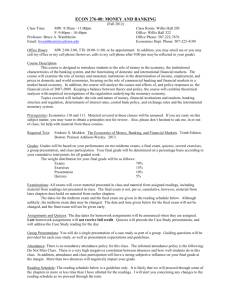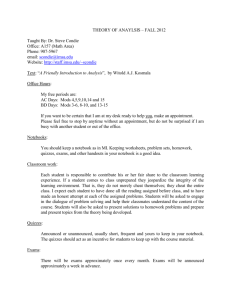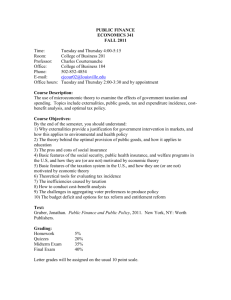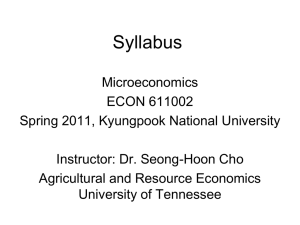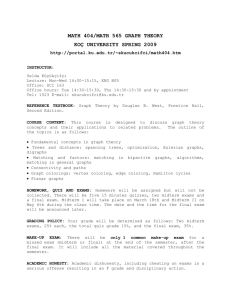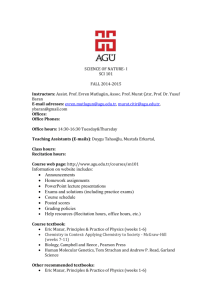sect. 1 w/Dr. Wang - California State University, Sacramento
advertisement
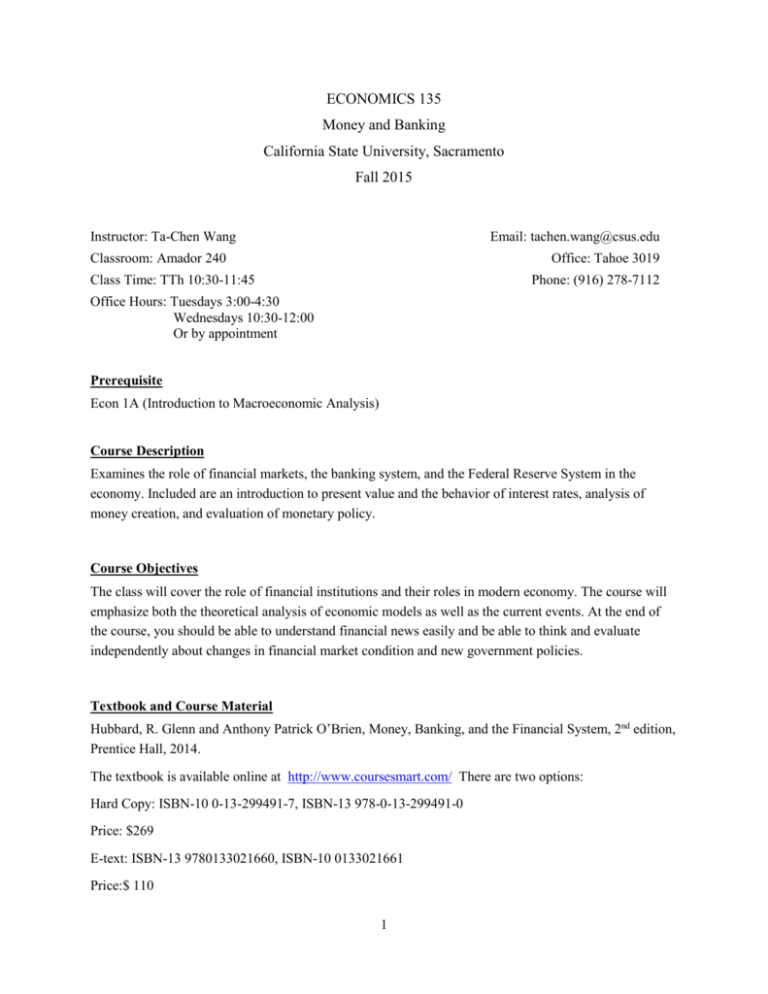
ECONOMICS 135 Money and Banking California State University, Sacramento Fall 2015 Instructor: Ta-Chen Wang Email: tachen.wang@csus.edu Classroom: Amador 240 Office: Tahoe 3019 Class Time: TTh 10:30-11:45 Phone: (916) 278-7112 Office Hours: Tuesdays 3:00-4:30 Wednesdays 10:30-12:00 Or by appointment Prerequisite Econ 1A (Introduction to Macroeconomic Analysis) Course Description Examines the role of financial markets, the banking system, and the Federal Reserve System in the economy. Included are an introduction to present value and the behavior of interest rates, analysis of money creation, and evaluation of monetary policy. Course Objectives The class will cover the role of financial institutions and their roles in modern economy. The course will emphasize both the theoretical analysis of economic models as well as the current events. At the end of the course, you should be able to understand financial news easily and be able to think and evaluate independently about changes in financial market condition and new government policies. Textbook and Course Material Hubbard, R. Glenn and Anthony Patrick O’Brien, Money, Banking, and the Financial System, 2nd edition, Prentice Hall, 2014. The textbook is available online at http://www.coursesmart.com/ There are two options: Hard Copy: ISBN-10 0-13-299491-7, ISBN-13 978-0-13-299491-0 Price: $269 E-text: ISBN-13 9780133021660, ISBN-10 0133021661 Price:$ 110 1 Please also notice that previous versions of the book will also work for this class. These include the first edition of the book and this one: Hubbard, R. Glenn, Money, the Financial System, and the Economy, 5th and 6th edition, Pearson AddisonWesley, 2007 I will post lecture notes on SacCT. They will come in the form of PowerPoint slides. Exams and Assignment There will be three exams and approximately 6 online quizzes. Also, I may add in-class exercises to reinforce the understanding of the topics covered in lectures. There may also be in-class questions for discussion. Exams The exams are non-cumulative and each will count as 28% of your grade. Midterms 1st midterm: 10/1 (Thu) in class 2nd midterm: 11/5 (Thu) in class The midterm exams will last for 75 minutes. Final 12/17 (Thu) 10:15-12:15 Exam Policies All exams are closed-book, closed-note. You are responsible to bring a Scantron form (#882-E) and a simple calculator. The uses of smartphone, regular cell phones, and note cards are strictly prohibited. The instructor reserves the right to change seating arrangements during the exams. If you miss an exam due to illness or other necessity, you must contact me prior to the exam time and provide a legitimate university excuse before you will be able to make up the work. If you are ill, you need to provide me with a physician’s note that clearly states that you could not have taken a midterm or final on the date it was given. Merely being seen by a physician is not sufficient. Failure to provide a legitimate university excuse will result in a zero on the exam. 2 Online Quizzes There will be approximately 6 online quizzes. I will automatically drop 1 lowest score (in terms of percentage) of your quizzes. The quizzes are done online on SacCT and graded automatically. They will count as 16% of your final grade. No late quizzez are accepted. Due dates for all assignments are posted on SacCT in advance. It is not possible to extend time for assignments after the due date. If you add the course late in the semester, you cannot makeup work you have missed. Give yourself ample time to complete the quizzes. These quizzes are challenging and important both for your homework grade and your performance in the class. I encourage you to review class material first before you start the quizzes. Answer keys for all material will be available online on SacCT after the due date and time. Please be sure to review your problem sets before exams. Grading Scale Each exam accounts for 28% of your final grade, and the homework assignments (after dropping the lowest score) make up 16% of your grade The curve looks roughly like this: 87+ A and A74 to 87 B+, B, and B60 to 74 C+, C, and C55 to 60, D+, D, and DBelow 55 F Please notice that I will adjust the curve according to the relative performance of the class. However, you will not receive anything above a D if your final score (exams and homework combined according to the weight above) is less than 60. Also, you will not pass the class if your final score is less than 55. Course Policies 1. Due to room capacity, classes are not allowed to go above the cap (40 for this class). I can only sign add slips if there are spaces open up. 2. All exam dates are set (see above). If you already have obligations that prevent you from taking any of the exams, you should not take this class. Please schedule your other engagements around the exam date. 3. Academic honesty is expected. You will receive a mark of zero on any work (including exams) where cheating occurs. Please make sure you read the University Policy on Academic Honesty: http://www.csus.edu/admbus/umanual/UMA00150.htm There is also a useful student tutorial on this issue: http://library.csus.edu/content2.asp?pageID=353 4. Attendance is highly recommended. If you miss a class, be sure to check with your fellow classmates, and the course web page to see what material you missed. 3 5. If you decide to withdraw from this class, please make sure you do so with the registrar. If you withdraw without permission, you will be assigned a failing grade. 6. I will do my best to respect everyone, and I expect you to do the same to your fellow colleagues. Please minimize disturbances (such as turning off cell phone ringers.) Also, please do not browse the Internet, chat online with friends, play video games, or text message in class. These activities are disruptive to your fellow classmates. If found doing any of the above, you may be asked to leave the classroom. 7. Classroom discussion is encouraged. However, please make sure to stay on the very topic of the lecture. If not, I may stop the discussion. 8. If you have a disability and require accommodations, you need to provide disability documentation to SSWD, Lassen Hall 1008, (916) 278-6955. Please discuss your accommodation needs with me after class or during my office hours early in the semester. Course Website On SacCT. (https://online.csus.edu/) To use the website, you will need your Saclink ID and password. Course material, including lecture handouts, problem sets, practice exams and solution, and announcements will be posted on SacCT. Please check the website regularly. In addition, all important notices will be sent through the SacSend system, so please make sure that your email addresses are up to date. Holiday Information For this class, we will have no classes on the following days: 11/26 (Thanksgiving Day) 4 Course Outline (Tentative) Section 1: Overview of the Monetary System and Financial Markets Chapter 1 Introducing the Financial System Chapter 2 Money and Payment System Quiz 1 Chapter 3 Interest Rate and Rates of Return Chapter 4 Determining Market Interest Rates Quiz 2 Chapter 5 Risk Structure and Term Structure of Interest Rates Midterm 1 Chapter 6 Stock Market, Information and Financial Market Efficiency Chapter 7 Derivatives and Derivatives Markets Quiz 3 Section 2: Financial Institutions, Regulations, and Central Bank Chapter 9 Transactions Costs, Asymmetric Information, and the Structure of the Financial System Chapter 10 The Economics of Banking Chapter 11 Investment Banks, Mutual Funds, Hedge Funds, and the Shadow Banking System Chapter 12 Financial Crises and Financial Regulation Quiz 4 Midterm 2 Section 3 Money, Monetary Policy, Inflation, and Economic Fluctuations Chapter 13 The Federal Reserve and Central Banking Chapter 14 The Federal Reserve’s Balance Sheet and the Money Supply Process Quiz 5 Chapter 15 Monetary Policy Quiz 6 Final 5


